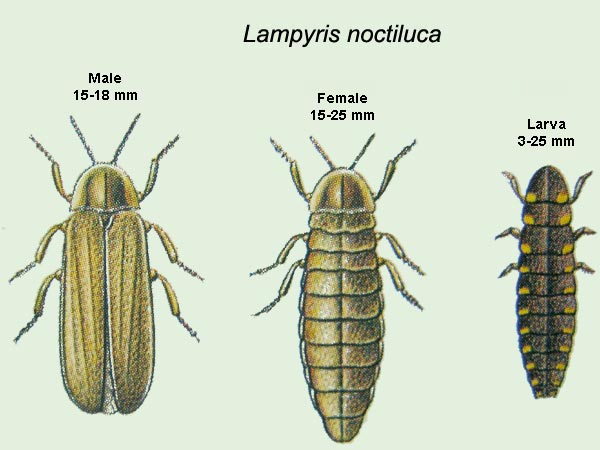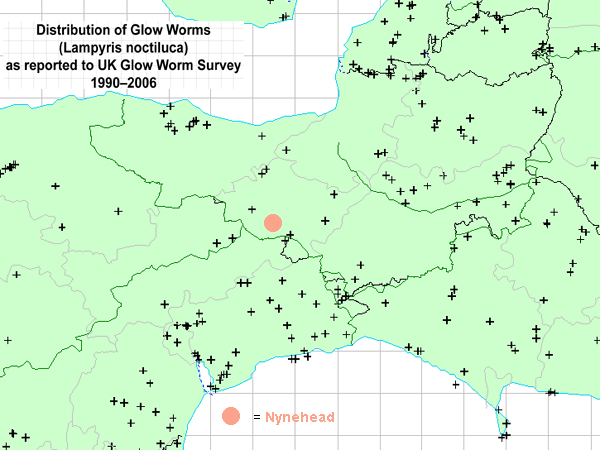National Glow Worm Survey
According to the National Geograpic [June 2009] there is a world-wide "dramatic decline in fireflies." In the UK these creatures are known rather bizarrely as glow worms [Lampyris noctiluca] They resemble worms hardly at all as they are beetles!

There are a number of studies being carried out world-wide to try and account for the apparent decline in numbers. Prime suspects are loss of habitat and light pollution. Details of the UK survey can be found atgalaxypix.com/glowworms which contains a great deal of information and has links for recording sightings etc. It appears from the distribution map below that Nynehead has no recorded sightings. As well as being indicated on the map, Somerset sightings are listed at the foot of the page.

The remainder of this text is taken from the UK glow worm website whose survey began in 1990 and exists solely to gather information about these fascinating insects that most people don’t even realise exist in Britain.
Information comes mostly from members of the public who see glow worms and want to know more about them. Before the survey started, it was said that there were fewer than 100 sites where glow worms could be found in the UK. The survey has shown that there are in fact hundreds of sites throughout the UK where they can be seen, and more sites are reported every year. Please note that we never give out or list details of glow worm sites on private land, other than to bona fide researchers, so if you have glow worms in your garden please tell us without worrying that you will get hordes of unwanted visitors in the dead of night! You can report a site to us by email or by filling in an online form. Oh, and please don't send any pictures without prior arrangement – too many can overload my mailbox.
The survey has been publicised in particular by the Weekend Telegraph (July 2006), National Trust magazine (Summer 2005), BBC Wildlife Magazine, on BBC Radio 4, and by BBC TV’s Country File.
Key glow worm facts
- Only adult females glow, to attract the flying males
- Adult glow worms can't feed, so they can live only for 14 days or so
- Once a female glow worm has mated, she turns out her light, lays eggs and dies
- Leave glow worms where they are – they know best where they like to be
- Don’t take glow worms home – they need specialised habitat
As we travel in our cars from one brightly streetlit area to another, we are unlikely to notice the tiny lights of glow-worms, about as bright as an LED indicator on a hi-fi. Yet they are still to be found, and they may be more common than you think. But despite surveys over the years, researchers are still in the dark over the factors affecting the decline of glow worms. What is needed is the widest possible survey of the remaining glow-worm habitats, which is where you can help.
The glow worm, Lampyris noctiluca, is not at all worm-like but is a beetle up to 25 mm long. Only the wingless female glows strongly, to attract the flying males. Each individual female has an adult glowing life of only a few weeks until she mates, since she dies soon after laying her eggs.
After a few weeks the eggs hatch into larvae, and they remain as larvae for one or two further summers, feeding on small snails which they apparently paralyse before sucking them empty. The two- or maybe even three-year gap between a mating and the subsequent appearance of an adult helps to explain why you may find plenty on a site one year, yet few or none at all the next. And, of course, sites where they seem to have died out can’t be written off on the basis of a single night’s search.
The adult female and larva look very similar at first sight, but the larva has very obvious light spots on the rear edge of each segment, while the adult female has a completely black back with just a thin paler line down its centre. The larva has only a small light-emitting region on the underside of the final segment, which appears lighter, while in the adult female the final two rear segments glow and are lighter in colour. The adult male has black wings. You can see these differences in pictures in the gallery.
Where and when to look
Where should you look for glow worms? Though they are said to favour chalky or limestone areas, they have been reported from many areas of Great Britain. The peak glowing period is evenings in June and July. People are often surprised to discover glow worms in gardens, hedgerows or railway embankments where they had never been noticed before. Disused railway lines are prime sites, in fact. Glow worms can also be found on cliffs, woodland rides, heathland and even valleys in Wales or Scotland which meet none of the above criteria! There are few counties in the UK where they are not found somewhere, though they are believed to be absent from the Isle of Man and Ireland. Having said that, I have had a report from Greystones, south of Dublin, which is awaiting more recent confirmation.
Some people like to keep glow-worm sites secret, for fear of the ‘egg-collector’ mentality, which I appreciate. But I believe that it’s better to educate people that glow worms are best left alone rather than taken in glass jars to entertain the kids, and the sites that are well-known and feature in glow-worm walks do not suffer any obvious problems. There are far greater threats to them from ignorance and from lack of knowledge that the glow worms are there.
Wherever you find small snails, though unfortunately not the large common-or-garden variety, it’s worth looking for glow worms. They prefer open grass or hedges to woodland, but rarely are they to be found on land which has been ‘improved’ for agriculture. Look for them from late May to early September (with a peak in mid July), as soon as it gets dark. They glow for a few hours at a time, and usually stop glowing soon after mating. If you do see glow worms, don’t disturb them and certainly don’t take them home as trophies, no matter how many there are on a site. Their continued existence at your site could be on a knife-edge. But a short look by torchlight will do no harm, and you may see the smaller, darker (and glow-less) male mating – perhaps even several on one female!
You may also spot larvae, particularly on dark, moonless nights. They glow much more faintly, and only intermittently, for a few seconds at a time. They are also not worm-like but have segmented bodies and six legs at the head end, quite similar to the adults. They do, however, sometimes help themselves along with their tails when moving, which makes them look a bit like caterpillars. You are more likely to see them on vegetation, searching for snails, than in the same areas as the glowing females. It is important for the survival of the glow worm to find the sites where the larvae live, since only about one per cent of its life is as an adult. Comparatively little is known about the preferred habitat of the larvae, so reports of them are always welcome. They appear over a longer time span than the adults, supposedly between April and October – probably whenever conditions are right for snails and slugs.
Glow worm sites in and around Somerset and Avon
A. Records published by Anthony Wootton (Country-Side 1971, 21 456-463 and 572-574, and XXII, No 6, Spring 1974, 266-271.)
NB: Comments such as '10 years ago' here refer from 1970s.
Wellington, c. 1908
Rumwell, June 1946
Pitminster, June 1953, 1954.
Bickenhall, abundant, June 1954.
Edington, 1 male at light, July 1951.
Ashcott June 1933.
Street, many, summer 1949.
Nr. Charterhouse-on-Mendip (ST 505557), June-July 1962.
Pilton, 1 male at light, July 1924.
3 miles S. of Bath, 1, 1968.
Batheaston, Nr. Bath, 19th century.
Oakford St. Catherine, Batheaston, several May 1968.
c.0.5 mile E. of Crewkerne station, (ST 458085), in garden and on adjoining railway bank, 1971.
Misterton, Nr. Crewkerne, dozens of larvae in forestry plantation, end October 1971.
Between Upton and Dulverton, numerous in hedgerows, 1943; none seen since 1965.
Webbers Post (just E. of Cloutsham Nature Trail), Horner, 1 female, June 1973.
Goblin Coombe (ST 492640), 1 female in rough scrub, early July 1973.
Lyatt-Dulcote area, Nr. Wells. numerous, including some on lawn of farmhouse, up to 1914.
Corton Denham, very numerous in hedgerows 1963-64.
Farleigh Hungerford, Nr. Bath (ST 803578), several in garden every year (1971).
South Stoke, Nr. Bath, several 1972-73.
B. Sites reported to Robin Scagell (all OS square ST sites, including some outside Somerset and Avon)
Site Map Location and details if any: f = (glowing) females
No Ref
577 ST057428 Watchet, along B3191 and field, also on old rly nearby.
511 ST097235 Langford Heathfield SSSI several f, 8.7.90
148 ST120409 Beacon Hill, Quantocks 3f 1991
509 ST187174 Quants NR bracken 1f. 2.8.90. No more found nearby.
090 ST2501 Dalwood, Honiton, Devon 1991
510 ST271208 Thurlbear Wood SSSI 1f 14.7.90
066 ST300046 Chardstock, Somerset 2f 1991
061 ST3203 South Common, Chard, Somerset 9f 1991
169 ST386555 Crook Peak, Mendips 100f 1991
563 ST4137 Shapwick Heath, early 1960s (cleared for peat extraction)
512 ST4138 Upper slopes of Turn Hill. Dozens, 6.7.90
557 ST4572 Larvae, Cadbury Camp, 11.5.91.
110 ST4828 Somerton, Somerset 1991
055 ST497552 Mendip Forest, Cheddar, Avon 1f 1991
054 ST505604 Blagdon Lake, Wrington, Avon 4f 1991
228 ST5545 Old railway embankment to SW of Wells. For last 6 yrs 3 f 1991
034 ST5703 Rampisham, Dorset 1991
175 ST592424 West Compton, Somerset 3f 1991
173 ST599408 Pilton, Somerset 2f 1991
515 ST610869 Old Down Hill, Olveston. At least 50 or 60 within 5 yrs
516 ST612873 Sheepcombe Woods. At least 50 or 60 within 5 yrs
039 ST629253 South Cadbury, Somerset 6f 1991
603 ST667269 Maperton Ridge, by old A303. 5f, July 1990.
176 ST698247 South Cheriton churchyard, Somerset 10f 1991
050 ST710295 Wincanton Racecourse, Somerset 3f 1991
502 ST7417 Road Stalbridge-Stalbridge Weston (20-30 y)
217 ST7495 Above North Nibley, Glos. Every year
514 ST7865 On canal bank between Bath and Bradford on Avon, 10-20f 1990
548 ST787302 Silton, verge of B3092, 1961-2
201 ST795203 Todborough 1991
584 ST8026 Railway embankment at Gillingham stn, for many years.
003 ST803610 Winsley, Bradford on Avon, Wilts 50f 1991
212 ST8111 Okeford Fitzpaine, Dorset 1991
230 ST8268 Lane at Henley nr Box, past 10 years
199 ST857107 Hod Hill 100f 1991
571 ST8707 Bryanston School, Blandford.
198 ST875164 Jerry's Hole, Sutton Waldron 160f 1991
200 ST879188 East Compton 1991
133 ST888181 Fontmell Down 9f 1991
232 ST9362 Seend Cleeve, on canal side opposite 'Barge' PH 1990,91
147 ST937608 Opp. 'Bell' PH, Seend, Wilts 20f 1991
202 ST952206 Tollard Down, Rushmore 1991
